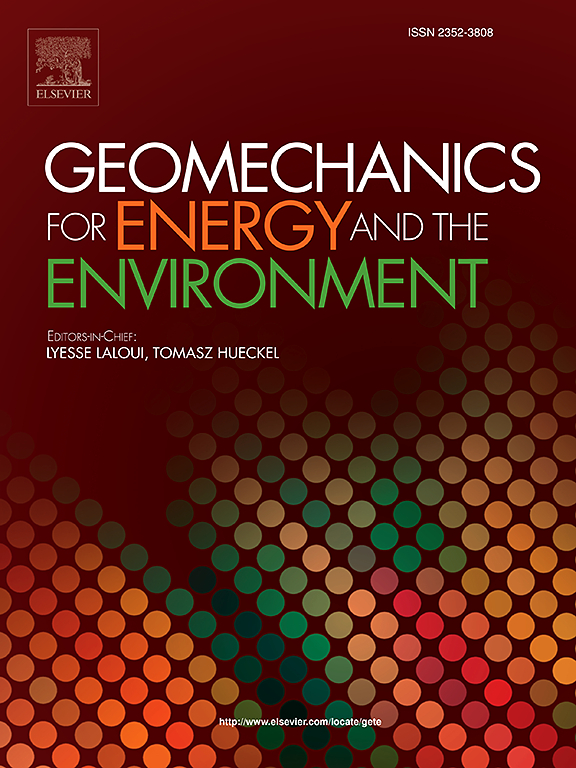Quantitative assessment of well leakage, part II: Case studies for CCS
IF 3.7
2区 工程技术
Q3 ENERGY & FUELS
引用次数: 0
Abstract
This paper presents the second part of a two-part series on estimating fluid migration along wells. We use the results of the model described in the first paper and outline a leakage calculation methodology. The present method considers the mechanical behaviour of the flow pathway, formation creep, visco-inertial effects, and the operational conditions of the well to provide a deterministic evaluation of fluid migration along the well. Two case studies are presented that focus on a CO2 injection well in a depleted reservoir and a legacy well in an aquifer CCS project.
The results indicate that there is a pressure threshold below which CO2 may not flow through the cemented annulus. Beyond that point, the flow rate increases non-linearly with storage pressure. The size of the leakage pathway changes over time with the pressure and temperature of the system and is not a static parameter. Visco-inertial effects and creep could reduce the potential leak rate. The computed rates should be considered as an upper bound in this work as the impact of multiphase flow was not considered. This type of assessment is critical to conduct quantitative risk assessments for CCS projects. The results enable operators to manage storage pressure, reduce the cost of MMV (Measurement, Monitoring, and Verification) plans, and improve well designs. We argue that the impact of the magnitude of leakage rates reported in this work should be weighed against the improvements to the economics of CCS projects with an increased pressure/storage capacity.
油井泄漏的定量评估,第二部分:CCS的案例研究
本文是关于流体沿井运移估计的两部分系列文章的第二部分。我们使用第一篇论文中描述的模型的结果,并概述了泄漏计算方法。目前的方法考虑了流动通道的力学行为、地层蠕变、粘惯性效应和井的操作条件,以提供沿井流体运移的确定性评估。本文介绍了两个案例研究,分别是枯竭油藏中的一口二氧化碳注入井和含水层CCS项目中的一口遗留井。结果表明,存在一个压力阈值,低于该压力阈值CO2不能通过胶结环空。超过这一点,流量随储存压力呈非线性增长。泄漏通道的大小随系统的压力和温度随时间而变化,而不是一个静态参数。粘惯性效应和蠕变可以降低潜在泄漏率。由于没有考虑多相流的影响,计算出的速率应被视为上界。这种类型的评估对于对CCS项目进行定量风险评估至关重要。该结果使作业者能够管理储压,降低MMV(测量、监测和验证)计划的成本,并改进井设计。我们认为,在这项工作中报告的泄漏率幅度的影响应该与增加压力/存储容量的CCS项目的经济改进进行权衡。
本文章由计算机程序翻译,如有差异,请以英文原文为准。
求助全文
约1分钟内获得全文
求助全文
来源期刊

Geomechanics for Energy and the Environment
Earth and Planetary Sciences-Geotechnical Engineering and Engineering Geology
CiteScore
5.90
自引率
11.80%
发文量
87
期刊介绍:
The aim of the Journal is to publish research results of the highest quality and of lasting importance on the subject of geomechanics, with the focus on applications to geological energy production and storage, and the interaction of soils and rocks with the natural and engineered environment. Special attention is given to concepts and developments of new energy geotechnologies that comprise intrinsic mechanisms protecting the environment against a potential engineering induced damage, hence warranting sustainable usage of energy resources.
The scope of the journal is broad, including fundamental concepts in geomechanics and mechanics of porous media, the experiments and analysis of novel phenomena and applications. Of special interest are issues resulting from coupling of particular physics, chemistry and biology of external forcings, as well as of pore fluid/gas and minerals to the solid mechanics of the medium skeleton and pore fluid mechanics. The multi-scale and inter-scale interactions between the phenomena and the behavior representations are also of particular interest. Contributions to general theoretical approach to these issues, but of potential reference to geomechanics in its context of energy and the environment are also most welcome.
 求助内容:
求助内容: 应助结果提醒方式:
应助结果提醒方式:


